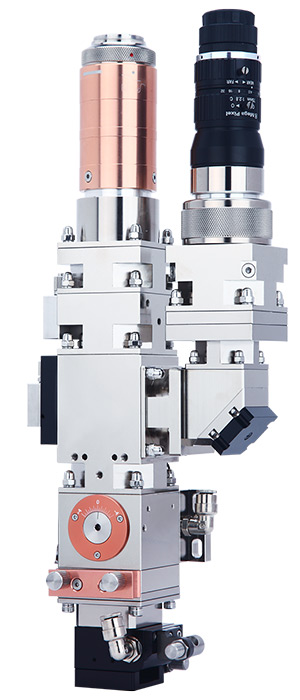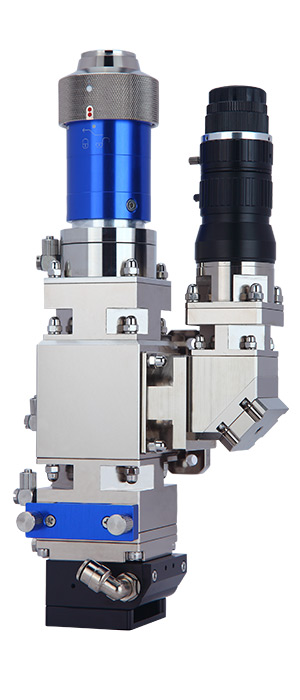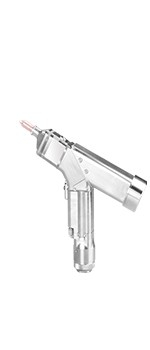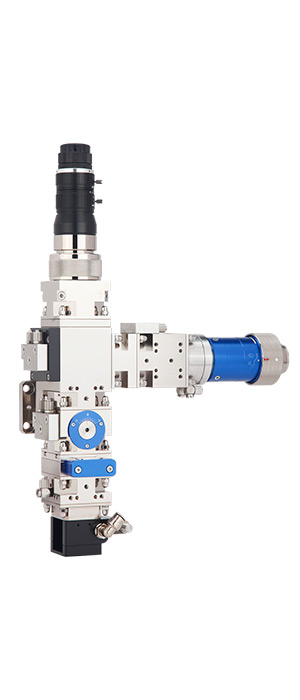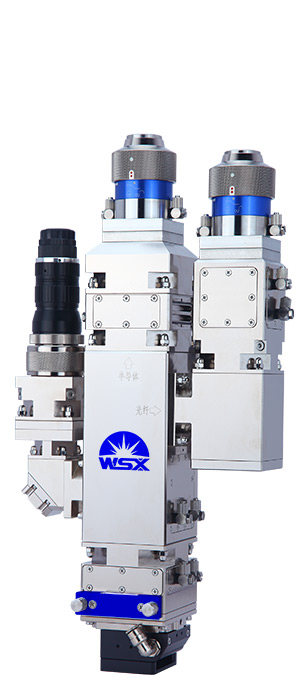Characteristics and application fields of laser welding head
Laser head technology uses a polarizer to reflect the beam produced by the laser in order to focus it in a focusing device to produce a high-energy beam. If the focus is close to the workpiece, the workpiece will melt and evaporate within milliseconds. This effect can be used to generate high-power CO2 and high-power YAG lasers during the welding process, opening up a new field of laser welding head welding. The key to laser welding head equipment is a high-power laser. There are mainly two types, one is solid state laser, also known as Nd:YAG laser. Nd (Neodymium) is a rare earth element and YAG stands for Yttrium Aluminum Garnet, which has a crystal structure similar to ruby. The wavelength of the Nd:YAG laser is 1.06 μm.
Its main advantage is that the resulting beam can be transmitted through an optical fiber, so there is no need for a complex beam delivery system. Suitable for flexible manufacturing systems or remote machining, usually for welding workpieces with high precision. Nd:YAG lasers have an output power of 3-4 kW and are commonly used in the automotive industry. The other is a gas laser, also known as a CO2 laser. Molecular gas is used as the working medium to generate an infrared laser with a uniform size of 10.6 μmm. It can work continuously and output high power. Standard laser power is between 2-5kW.

The main advantages of laser horns compared to other conventional horn technologies are:
1. Fast speed, large depth and small deformation.
2. Welding can be carried out at room temperature or under special conditions, and the welding head equipment is simple. For example, if the laser beam of a laser head passes through an electromagnetic field, the beam will not move; the laser can weld in vacuum, air, and some gas environments, as well as through glass or materials that are transparent to the beam.
3. It can weld refractory materials such as titanium and Shi Shi, and the welding effect of dissimilar materials is good.
4. After the laser is focused, the power density is high. When welding high-power equipment, the aspect ratio can reach 5:1, and the maximum can reach 10:1.
5. Micro welding can be performed. The focused laser beam can obtain a small spot and can be precisely positioned, and can be applied to the assembly and welding of micro and small workpieces for automatic mass production.
6. Welding hard-to-reach parts and implementing non-contact long-distance welding has great flexibility. Especially in recent years, optical fiber transmission technology has been adopted in YAG laser processing technology, which makes laser welding technology more widely promoted and applied.
7. The laser beam can be easily separated according to time and space, and multiple beams can be processed simultaneously in multiple stations, which provides conditions for more precise welding.

However, laser welding also has certain limitations:
1. The assembly accuracy of the weldment is required to be high, and the position of the beam on the workpiece cannot be significantly moved. This is because after the laser is focused, the spot size is small, the weld seam is narrow, and the interior is filled with metal materials. If the assembly accuracy or beam positioning accuracy of the workpiece cannot meet the requirements, it is easy to cause welding defects.
2. The cost of the laser and its related systems is high, and the one-time investment is large.

Laser welding joint technical parameters:
(1) Power density of laser welding head
Power density is one of the most critical parameters in laser processing. With higher power densities, the surface layer can be heated to boiling points in the microsecond time range, resulting in substantial vaporization. Therefore, high power density is beneficial for material removal processes such as stamping, cutting and engraving. For lower power densities, it takes a few milliseconds for the surface layer temperature to reach the boiling point. Before the surface layer evaporates, the bottom layer reaches the melting point, which can easily form a good fusion weld. Therefore, when laser welding is performed, the power density is in the range of 104 to 106 W/cm2.
(2) Laser pulse waveform of laser welding head
Laser pulse shape is an important issue in laser welding, especially for thin plate welding. When a high-intensity laser beam is incident on a material surface, 60% to 98% of the laser energy on the metal surface will be reflected and lost, and the reflectivity will vary with surface temperature. During the laser pulse, the reflectivity of the metal changes greatly.
(3) Laser pulse width of laser welding head
Pulse width is one of the important parameters of pulsed laser welding. It is not only an important parameter different from material removal and melting, but also a key parameter that determines the processing cost and processing equipment volume.
(4) The influence of the defocus amount of the laser welding head on the welding quality
Since the power density in the center of the spot at the laser focus is too high, it can easily evaporate into the hole. The power density distribution is relatively uniform in each plane, leaving the laser focus. There are two defocusing methods: positive defocusing and negative defocusing. The focal plane above the workpiece is positive defocus, otherwise it is negative defocus. According to geometric optics theory, when the distance between the positive and negative defocus planes is equal to the welding plane, the power density on the corresponding planes is approximately the same, but the actual obtained weld pool shape is different. When negative defocusing occurs, greater penetration can be obtained, which is related to the formation process of the molten pool.

Application fields of laser welding heads
Laser welding heads are widely used in manufacturing, powder metallurgy, automotive industry, electronics industry and other fields.
Application of laser welding head technology in automobile field
Currently, VW Germany uses laser welding heads to weld the tops of Audi A6, GolfA4, Passat and other brands. BMW and GM also use laser welding heads to weld the top of the frame. Mercedes of Germany uses laser welding heads to weld gearbox components.
In addition to laser welding, other laser welding technologies are also widely used: Volkswagen, GM, Mercedes-Benz and Nissan have applied laser cutting head cutting technology to cut hoods, Fiat and Toyota have applied laser coating to engine exhaust valves, VW has laser surface hardened on the engine camshaft.
Judging from the current domestic situation, the domestic models of international brands: Passat, Polo, Tuan, Audi, Dongfeng Peugeot, Fox, etc. all use laser welding head welding technology. Among them, the top cover of FAW-Volkswagen Audi A6 and the rear cover of Bora are welded by laser welding head, and the length of laser welding seam of Si Teng and Touran body is 30m and 40m respectively. In addition, domestic independent auto brands Brilliance, Chery and Geely have also successively applied laser welding technology to new models.

Improvement and development of new welding technology for laser welded joints
With the progress of the times, laser welding head welding technology is also constantly developing. The following technologies help to expand the application range of laser welding heads and improve the automatic control level of laser welding heads.
1. Filler wire laser welding head welding head
Laser welding heads are usually not filled with welding wires, but the assembly clearance of butt welded parts is very high, which is sometimes difficult to guarantee in actual production, which limits its application range. The use of wire-filled laser welding can greatly reduce assembly clearance requirements. For example, for an aluminum alloy plate with a plate thickness of 2mm, if filler wire is not used, the gap between the plates must be zero to obtain a good forming effect. For example, if a filler wire of φ 1.6 mm is used as the filler metal, good weld formation can be ensured even if the gap is increased to 1.0 mm. In addition, filler wire can also adjust the chemical composition or perform multi-layer welding of thick plates.
2. Beam rotary laser welding head welding
The method of welding by rotating the laser beam can also greatly reduce the requirements for welding components and beam alignment. For example, when butting a 2mm thick high-strength alloy steel plate, the butt assembly gap can be increased from 0.14mm to 0.25mm; for a 4mm thick steel plate, it can be increased from 0.23mm to 0.30mm. The allowable alignment error between beam center and weld center has been increased from 0.25mm to 0.5mm.
3. On-line inspection and control of welding quality of laser welding head
In recent years, the use of plasma light, sound and charge signals to detect the welding process of laser welding joints has become a research hotspot at home and abroad, and certain research results have been achieved in the closed-loop control process.









